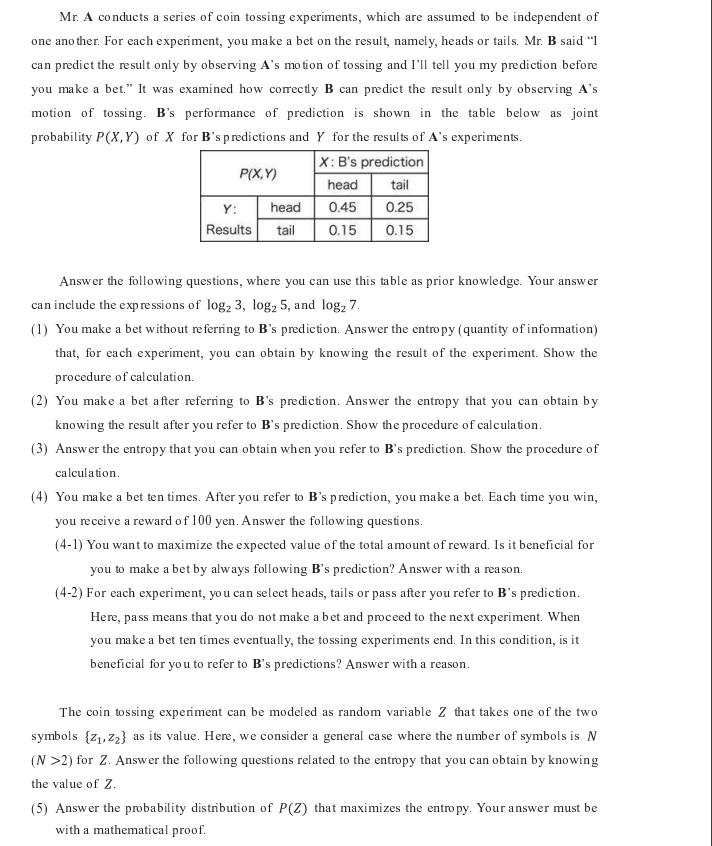Answered step by step
Verified Expert Solution
Question
1 Approved Answer
Mr. A conducts a series of coin tossing experiments, which are assumed to be independent of one another. For each experiment, you make a

Mr. A conducts a series of coin tossing experiments, which are assumed to be independent of one another. For each experiment, you make a bet on the result, namely, heads or tails. Mr. B said "I can predict the result only by observing A's motion of tossing and I'll tell you my prediction before you make a bet." It was examined how correctly B can predict the result only by observing A's motion of tossing. B's performance of prediction is shown in the table below as joint probability P(X,Y) of X for B's predictions and Y for the results of A's experiments. X: B's prediction P(X,Y) head tail Y: head 0.45 0.25 Results tail 0.15 0.15 Answer the following questions, where you can use this table as prior knowledge. Your answer can include the expressions of log 3, log2 5, and log2 7. (1) You make a bet without referring to B's prediction. Answer the entropy (quantity of information) that, for each experiment, you can obtain by knowing the result of the experiment. Show the procedure of calculation. (2) You make a bet after referring to B's prediction. Answer the entropy that you can obtain by knowing the result after you refer to B's prediction. Show the procedure of calculation. (3) Answer the entropy that you can obtain when you refer to B's prediction. Show the procedure of calculation. (4) You make a bet ten times. After you refer to B's prediction, you make a bet. Each time you win, you receive a reward of 100 yen. Answer the following questions. (4-1) You want to maximize the expected value of the total amount of reward. Is it beneficial for you to make a bet by always following B's prediction? Answer with a reason. (4-2) For each experiment, you can select heads, tails or pass after you refer to B's prediction. Here, pass means that you do not make a bet and proceed to the next experiment. When you make a bet ten times eventually, the tossing experiments end. In this condition, is it beneficial for you to refer to B's predictions? Answer with a reason. The coin tossing experiment can be modeled as random variable Z that takes one of the two symbols (Z, Z} as its value. Here, we consider a general case where the number of symbols is N (N>2) for Z. Answer the following questions related to the entropy that you can obtain by knowing the value of Z. (5) Answer the probability distribution of P(Z) that maximizes the entropy. Your answer must be with a mathematical proof.
Step by Step Solution
★★★★★
3.36 Rating (159 Votes )
There are 3 Steps involved in it
Step: 1
1 The entropy of a single coin toss without knowing Bs prediction can be calculated as follows HY PY log2 PY Where Y is the result of the coin toss he...
Get Instant Access to Expert-Tailored Solutions
See step-by-step solutions with expert insights and AI powered tools for academic success
Step: 2

Step: 3

Ace Your Homework with AI
Get the answers you need in no time with our AI-driven, step-by-step assistance
Get Started


